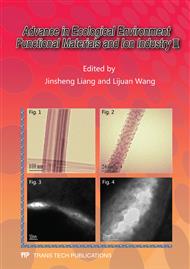p.38
p.45
p.51
p.55
p.60
p.64
p.70
p.77
p.82
Interfacial Morphologies of Methanol-Melamine-Formaldehyde (MMF) Shell MicroPCMs/Epoxy Composites
Abstract:
The aim of this work was to fabricate novel microPCMs containing dodecanol by an in-situ polymerization using methanol-modified melamine-formaldehyde (MMF) prepolymer as shell material and investigate the interface morphologies of microPCMs/epoxy composites treated by a simulant thermal process with a 10 times repeated temperature variation. A series of microPCMs were fabricated by 1000-3000 r·min-1 emulsion speed with the PCM contents of 40-70%. Micro-cracks and gaps occurred after a thermal treatment in the interface of microPCMs and epoxy matrix obviously. The internal stress generated by the expansion or shrinking of the microPCMs was the main factor leading to the interface morphology changes and damaged of composites.
Info:
Periodical:
Pages:
60-63
Citation:
Online since:
January 2012
Authors:
Price:
Сopyright:
© 2012 Trans Tech Publications Ltd. All Rights Reserved
Share:
Citation:


